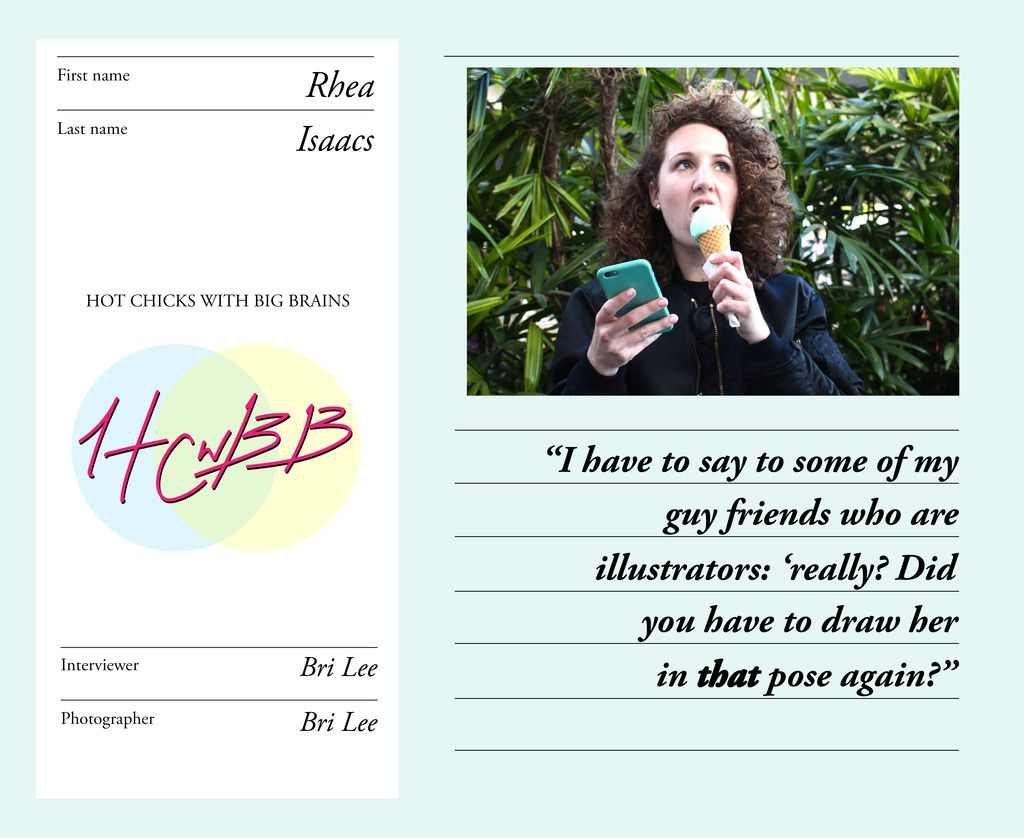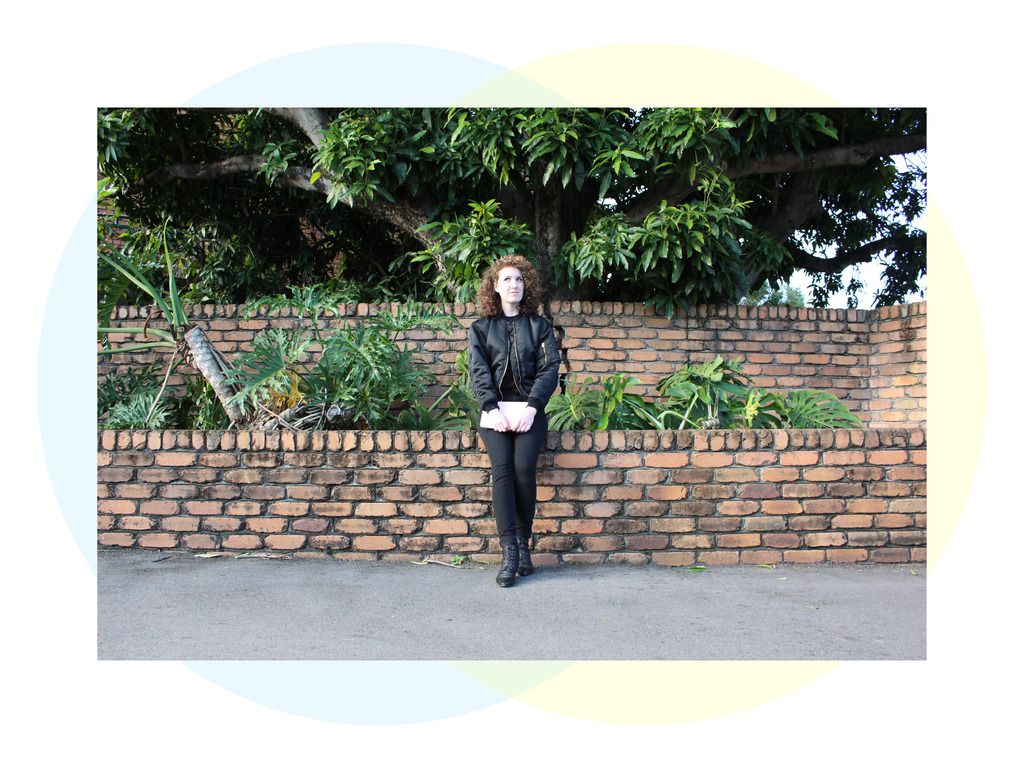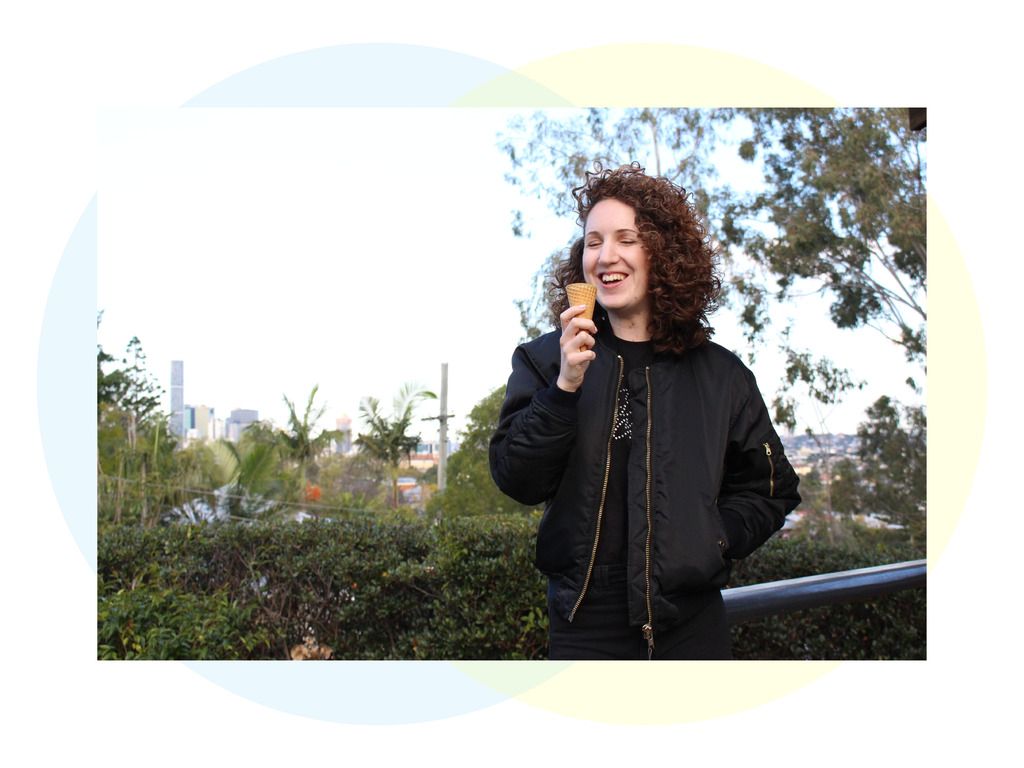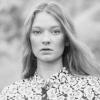This featured piece was originally published by Hot Chicks with Big Brains.
Hot Chicks with Big Brains (HCwBB) is an interview series determined to challenge the way women are often pigeonholed. They feature discussions with successful women who appreciate a curated sense of self. Women who are both form and function. Interviews begin by focusing on the relationship between work and personal style, but quickly (and often) digress into insightful life stories.
Illustrator Credit: YoungEarlGrey
In this extract, Founder and Chief Interviewer Bri Lee speaks to Brisbane based artist Rhea Isaacs, who goes by YoungEarlGrey, about fine art, bad men, Paris, and the Paris of the Asia Pacific (Brisbane).
Rhea and I met at the Paddo pub (yes, that’s about as Brisbane as it gets) on a hot afternoon a few weeks ago. I had been to an exhibition that featured her work then fallen in love with her style after following her social media presence. We spoke about her incredible aesthetic and her impending move to Paris.
B: How did you first get into art and find your style?
R: I went to high school out near Strathpine and it was a terrible experience for me so I guess I used drawing as a way to escape from that. When I graduated I went to Quantum University in Sydney but found out that I hated animation with a passion. Having to draw the same thing over and over. I just can’t do it. So I kind of floated around Sydney for six months or so before applying for this brand new illustration degree in Melbourne and it was really good for my work but moving to Melbourne was hard.
B: How old were you?
R: 19. And I didn’t have any family there and I was meant to do 3 years but at the end of 2 I’d had enough so I went back to Sydney to Sydney College of the Arts. I thought art school would be easy but it’s super intense, and for the second two years you just do your own project. For me that was so good, because I had guidelines but could actually explore myself conceptually.
I always thought art was a bit wanky in terms of: ‘Oh, all these people came before you and you have to know the history,” and all that. But actually going through the history of art and realising that where you are now is actually connected to all these people who’ve come before you was so amazing. Realising that my art isn’t just drawing. It has so much meaning.
So I did 2 years of honours then tried to move to LA, but I’d never been overseas before. I lasted about 5 weeks and got so homesick and so directionless. The whole thing with LA was that I thought it was so important to go to America because I love American culture and media, all that imagery-
B: -and LA makes me think of all your 80’s imagery-
R: -Exactly! Except when I went there it totally wasn’t like that. It was barren like a dustbowl and not 80’s at all. I just had so many expectations. So many things I thought were so “me” were based on that idea I had of LA, and I went there and said: “Woah, this is not what I expected, and actually, I feel like I’m more connected to the imagery from Australia that’s trying to replicate America, rather than America in actual fact.”
So I moved back to Syndey and did my thesis on that and then really shut the door on decoding-my-childhood. After that I struggled a little. Deciding what to do with my artwork. Earlier this year I saved up and went to Paris, and I met a guy, and Paris is the most amazing city. I’m moving back in November. Going to Paris was so helpful because I didn’t know what it was going to be like there.
B: I had a huge life-changing epiphany when I went to Paris for the first time. It sounds cliché-
R: -but it’s true! I went there with plans to meet specific people for my work and it never eventuated - it actually blew up in my face - but in a way it was good. I had a bit of a depressive episode, but then I was reminded that my artwork is about making people feel good, reminding people of their childhoods and fun stuff. That’s why I draw women so often too, because I want to make women feel good without necessarily being so sexualised.
B: Yeah! It’s so great to see such cool artwork that has tons of chicks in it, and they’re wearing all their clothes!
R: I have to say to some of my guy friends who are illustrators: “Really? Did you have to draw her in that pose again?” And I don’t have a problem with short dresses and stuff, but it’s about how they’re constantly presented and their agency. I know it’s drawing, but still.
B: They don’t exist in isolation. And people consume them by choice but then maybe – especially young people - don’t realise they’re internalising those messages.
R: Exactly.
B: One thing I really want you to talk about is how your work has such a strong vision and feel to it. When I was looking through your portfolio I noticed all the women have incredible jackets and incredibly curly hair. Then, before me we met, I found picture of you and you dress so well! Like these women! And you have amazing curly hair like these women! What attracts you so wholly to that aesthetic?
R: I guess I’ve always been really into mood and atmosphere, and I’ve always been obsessed with movies and music. I always listen to music when I draw. I was really into Back to the Future when I was 13, and 70’s and 80’s stuff. My mum and dad are pretty old, they’re from the generation closer to most 20 year-olds’ grandparents, and I absorbed so much of their culture growing up.
B: I’ve heard you say before about the figures that you draw, the male and female ones, that they could be you or they could be someone else. That you’re drawing parts of yourself. Can you explain that a bit?
R: Yeah, I’m not a big believer in gender anyways. It doesn’t matter to me. I look up to people like Michael Jackson, who was always a bit genderless anyway. Paula Abdul. Flashdance! The main girl in that is so rough-and-tumble, but she can dress herself up as well. When I draw it’s not really a gender. It’s how I feel in the moment I’m drawing, but not necessarily me. I do kind of always draw the same cast of characters. Sometimes some of them have green or blue skin. Sometimes they’re robots not human. It’s not a big deal.
B: What about publicising your work? Do you feel pressure to be “that person” so people think you’re “cool”?
R: I guess. I mean, I’ve built my entire career out of social media. I started out on Tumblr in 2009 and people got interested in that then I moved to Instagram. Sometimes I feel like I have to dress 80’s because people expect me to now. Early on when I started posting pictures with me in them, or pictures of my outfit, people responded really well. And I thought: “Oh, okay, people see me as an extension of my artwork.” So I decided to make the most of that.
B: I like that you are real about that. Being commercially-minded as an artist means being sustainable.
R: Absolutely. And before I started posting pictures of myself on Instagram everyone just assumed I was guy because a lot of my early artwork is 80’s and Michael Jackson. And I don’t draw pink, glittery stuff that often, and when I do, my girls are very-
B: -Badass.
R: Exactly!
R: So they would email me and say: “Hey Earl,”
B: Oh, I suppose the name contributes to that presumption.
R: I dunno. I still find it interesting. I’ve even been treated like an idiot in my jobs. My dad used to run a printing company and I’ve had four years of training as a print assistant, and we have those huge Xerox machines. I remember this guy came in to fix it once and my dad was out of the office, and I said to him: “This is what’s wrong with it, this is what needs to be fixed, how about I do this and you do that?” And he said: “No sweetheart, I think I know what I’m doing. You should step aside until your dad comes back.”
B: Oh no.
R: And it’s like: “Fine, alright.” What can you say?
B: But you’ve been accepted more broadly?
R: Yeah. Especially in Paris. People in France don’t have a problem with women the same way Australians do.
B: I know what you mean. Going back a little bit though – why do you think people respond so positively about you being in the images sometimes? And how does that make you feel?
R: I feel good about it. Because I didn’t have a good time in high school. I got teased about my hair and how I dress. But now people think it’s cool, so I guess if they think it’s cool now then I might as well capiatalise on that. It took me a long time to feel comfortable with my looks. For the longest time I thought I was gonna be ugly forever.
B: Same. Because boys didn’t like me.
R: Yeah, same! And my style has changed because I used to try and hide my body a lot more. But over the years I’ve embraced myself.
B: I’m so impressed! You’re so young to have so much direction. Your work has such an incredibly strong aesthetic and so do you.
R: Thank you! I was literally a loner for, like, 3 years.
B: Yeah, I wore exclusively oversised boys’ clothes until I was about 18.
R: Oh yeah, I mean, we’re both tall. I can’t really wear skirts. The last time I wore a skirt I was in Kings Cross in Sydney at about 10pm at night and this guy just came along and smacked my arse. Full-on smacked it – you could hear it. I’m like: “What the fuck do you think you’re doing?” and he just leered at me.
B: Jesus. That’s disgusting and horrible. I’m sorry that happened to you.
R: And I just don’t wear clothes like that because I know I’m gonna attract attention.
B: That’s shit.
R: I know.
B: Well, what’s next for you?
R: Back to Paris. I feel at home there. The energy and the attitude. Paris has so many opportunities for me as an artist and illustrator. They just respect the practice a lot more and there’s a lot more money put into it. I love Australia, but really what I want to do is bring everything I love about Australia to Paris.
B: Ahhhh. I get it. I get it. That’s so exciting. Good luck!
Rhea has been in Paris for two weeks now and I’m flattered to say we still keep in touch. I commissioned an original work from her for Hot Chicks with Big Brains and couldn’t be happier with how it turned out.
If you enjoyed this, then check out:
Rhea Isaacs's work at her website http://www.youngearlgrey.com/
Bri Lee's piece for Writers Bloc about choosing writing over her day job.
This is a Bloc Feature, part of a curated selection of some of the most exciting new writing from Australia and the world. To read more from the series, click here.
Bri Lee
Bri Lee is a Brisbane-based writer and the founder of Hot Chicks with Big Brains. She also works in photography, videography, and editing, and her work has appeared in Scum, Voiceworks, Acclaim, and Spook.







